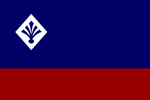IIWiki:Today's featured article: Difference between revisions
(May 2020 Update) |
(June 2020 Update) |
||
| Line 1: | Line 1: | ||
<div style="float:left;margin:0.5em 0.9em 0.4em 0;">[[File: | <div style="float:left;margin:0.5em 0.9em 0.4em 0;">[[File:Flag_of_Orioni.png|150px]]</div> The '''Flag of Orioni''', (Orinese: Ilibati) is a symbol of the Orioni Empire that inherits a historical tradition of using national symbols and is an attribute of the imperial government and executive powers. The flag features two horizontal blue (top) and red bands charged with a white diamond shield at the canton. As the color of the sky and water, blue represents a pigment highly prized in [[Orioni]] for decorating temple ceilings, the color signifies divine favor. Red is worn by brides in the Orient as a symbol of good luck and fertility. White is the color most associated with sacredness. The diamond shape is an early [[List_of_Spoken_Languages_on_Eurth|Oharic]] representation of a heart or womb, dating from circa 3000 BCE. The tree is Orioni's imperial symbol. Presence and position of the tree on the shield is directly inspired by the Orioni cedar (''Cedrus orioni''). The Cedar is a symbol of holiness, eternity and peace. As an emblem of longevity, the cedar of Orioni has its origin in many liturgical or apocryphal references. ('''[[Flag of Orioni|See more...]]''') | ||
<div align="right"> | <div align="right"> | ||
Revision as of 23:11, 1 June 2020
The Flag of Orioni, (Orinese: Ilibati) is a symbol of the Orioni Empire that inherits a historical tradition of using national symbols and is an attribute of the imperial government and executive powers. The flag features two horizontal blue (top) and red bands charged with a white diamond shield at the canton. As the color of the sky and water, blue represents a pigment highly prized in Orioni for decorating temple ceilings, the color signifies divine favor. Red is worn by brides in the Orient as a symbol of good luck and fertility. White is the color most associated with sacredness. The diamond shape is an early Oharic representation of a heart or womb, dating from circa 3000 BCE. The tree is Orioni's imperial symbol. Presence and position of the tree on the shield is directly inspired by the Orioni cedar (Cedrus orioni). The Cedar is a symbol of holiness, eternity and peace. As an emblem of longevity, the cedar of Orioni has its origin in many liturgical or apocryphal references. (See more...)
KEEP THIS ONE PARAGRAPH IN LENGTH so it doesn't push the main page section down below the other section.
